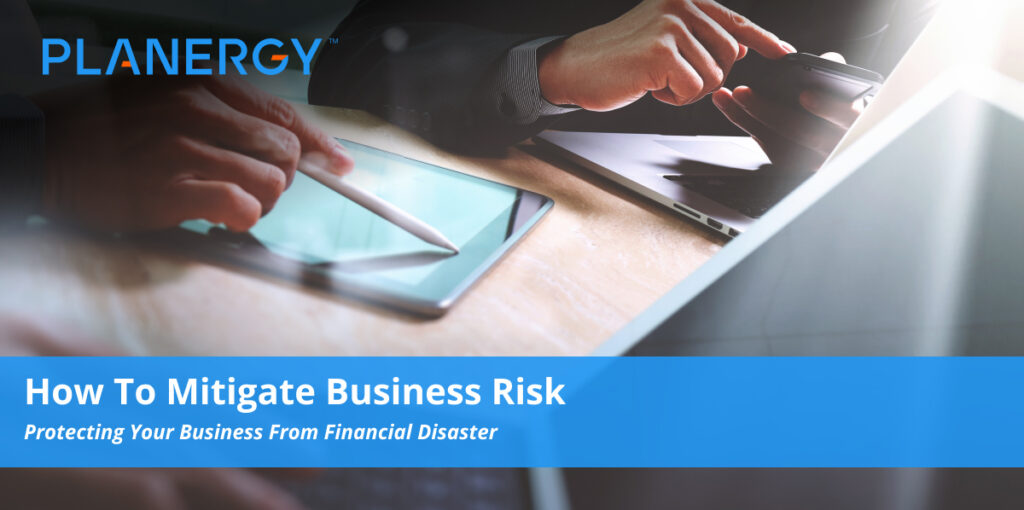Risk is an unavoidable part of doing business. It comes in an array of forms, each with their own unique potential for devastation, and although no business can hope to escape all of them unscathed, risk management provides companies with a set of strategic tools to limit the type and extent of risk they’ll suffer.
This is true even during times of minimal disruption. But for those doing business during a global disaster—such as the COVID-19 pandemic—and attempting to navigate the potential recession that may follow, finding ways to mitigate business risk is crucial not just to growth or expansion, but to financial stability and survival.
Rising to the challenge of effective risk mitigation during a recession or other crisis begins with understanding the types of risk that affect your business—and developing a complete risk management plan that’s versatile and strategic enough to help your company survive the crisis and continue to manage risk once recovery begins.
How You Mitigate Business Risk Matters
Everyone’s aware of risk as a threat to the financial health and operational continuity of businesses.
But in order to limit your own business risk effectively, and ensure your approach is flexible and comprehensive enough to cover the full range of risk factors in good times and bad (especially bad), you need to:
- Understand the different types of risk.
- Perform a risk assessment to identify the risk factors most likely to affect your business.
- Measure the potential impact of each potential risk and rank accordingly.
- Develop contingency plans based on:
- Risk Prevention (i.e., proactive preventative protocols, behavior, and training to reduce the chances specific risks and their consequences will occur).
- Risk Mitigation (i.e., detailed strategies for minimizing the impact and cost of risks that do occur).
- Risk Sharing (i.e., dispersing risk exposure between your company and third-party organizations).
- Risk Acceptance or Risk Retention (i.e., acknowledging and accepting the risk in part or whole, as well as its impact on your business and any related costs or penalties).
- Establish protocols to monitor risk levels at all times, identify new risks and changes to existing risk factors, and provide guidance in developing or modifying your action plans accordingly.
As a business strategy, this cyclical, ongoing approach to risk management provides a steady stream of information that allows companies to react with greater agility and contextual intelligence than if they relied on periodic “spot checks” alone.
This agility is particularly important to business continuity when natural disasters, pandemics like COVID-19, or political unrest strike.
Events that disrupt the world economy can quickly lead to recessions or worse, and having a plan that allows you to identify new risks created by changing conditions and deploy contingency plans for them can mean the difference between finding ways to stay afloat and sinking beneath the waves.
A steady stream of information allows companies to react with greater agility and contextual intelligence than if they relied on periodic “spot checks” alone.
Identifying Potential Risks and Their Origins
Before you can prevent or mitigate risk, you need to identify those with the largest potential effect on business operations and continuity, as well as general risks that are less likely to impact your business, but still require an action plan in the event circumstances change.
Small businesses and large corporations alike can benefit from examining the most common types of risk, then drilling down to prioritize and develop contingency plans in response to each based on high risk, moderate risk, and low risk levels.
Physical Risks
Whether you do business with brick-and-mortar, offer goods and services in cyberspace, or both, chances are your business has at least some physical aspects, and assets, that can create risk to your company, employees, and profits.
Some examples of physical risks include:
- Hazardous Materials can create health and safety risks if mismanaged, including fire, explosions, and harm or risk of death to employees. They include:
- Gases
- Toxic dust, filings, or residue
- Poisonous compounds, waste, or liquids
- Acid
- Building Risks are common for any company that owns, leases, or uses a physical space to do business. They are largely related to structural and maintenance concerns, such as fire, collapse, sick building syndrome, etc.
- General Location Risks are related to the physical site of the business. They include:
- Risk of exposure to isolated or recurring natural disasters (e.g., floods, fires, hurricanes, tornadoes, etc.).
- Risk created by proximity to other locations that may be dangerous to the health and safety of employees (e.g., a nearby hazardous materials site or military installation).
- Risk created by lack of training and education related to location-specific risks (e.g., no official hurricane response plan for a coastal business, no fire safety training for areas known to suffer from seasonal wildfires, etc.).
Team and Technology Risks
Both your team and the tools they use to get the job done can present their own set of risks to your business continuity if not properly trained and utilized, respectively.
- Staff Risks are part and parcel of doing business with human team members. High risk exposure can come from a variety of human-related behaviors and circumstances, including:
- Fraud and theft.
- Illness and injuries.
- Drug and alcohol abuse.
- Reduced productivity due to a lack of proper training or accountability.
- Technology Risks are always present in our global, always-on economy. The most common tech-related risks include:
- Telecommunications failure.
- Power surges and failures.
- Hardware and software failures.
- Inefficient or incorrect use of technology related to inadequate or incomplete training (overlapping with staff risk).
Strategic Risks
Even in the most staid of industries, choosing to do business is a gamble.
Every business takes chances (ideally, well-informed and strategic ones), and risk—in this case, potentially profitable risk—is introduced through them. Examples include:
- Market investments.
- Extending credit or loans.
- Investing capital in research and development of new products.
- Partnerships and marketing initiatives.
External Risks
As the name implies, these risks are created largely by external forces over which you have little or no control, and possibly little to no ability to predict without formalized risk mitigation strategies.
They are, however, some of the most important to plan for, as they can possess the potential to cripple or even bankrupt your business. Examples include:
- International political conflict or war.
- Pandemics (e.g., COVID-19)
- Natural disasters (in this instance, natural disasters that may or may not be directly related to location risk; e.g., changing weather patterns create tornadoes, wildfires, etc. in locations historically free from such events)
- Global market and supply chain disruptions caused by conflict, natural disasters, pandemics, etc.
- Contextual risks created by unprecedented or unusual circumstances. For example, the COVID-19 pandemic has created new risks for companies in the form of:
- Increased risk of health issues related to direct social contact, and the need to effectively implement social distancing protocols.
- Reduced employee availability due to isolation and shelter-in-place orders, especially for businesses that have no established remote working plan or whose business models do not support remote work.
- Massive supply chain disruptions due to business closures, logistics issues created by the need for social distancing protocols in all industries, etc.
- Economic disruption in the form of reduced investments, high unemployment, and impending recession.
- Greater overall risks to business continuity due to political and economic instability creating sociopolitical conflict and substantial and potentially enduring changes to established practices.
- Economic devastation caused by conflict, natural disasters, pandemics, etc.
- Cyberattacks
- Terrorism
Identifying the risks most relevant to your company’s risk management plan can be done in a number of ways:
- Market and industry research.
- Trend analysis to identify global, regional, and local risks affecting not just your company but the economy.
- Detailed analysis of your current workflows, staff, assets, and obligations to identify areas that create risk exposure.
Business Risk Mitigation Strategies
Once you have assembled your list of identified risks, the next step is developing a risk management strategy to prevent them, or at least minimize their associated impact on operations, competitive performance and financial strength.
Following these best practices when developing your business risk mitigation plan will help you adhere to the cyclical approach of Identify, Assess, Plan, Monitor, and Modify and incorporate both continuous improvement and flexibility into your risk reduction and overall business process management.
1. Perform a Detailed Risk Assessment.
In reviewing each potential risk, assign it a risk level based on probability of occurrence:
- Extremely likely.
- Moderate probability of occurrence.
- Minor probability of occurrence.
- Minimal probability of occurrence.
You can further refine this assessment by then reviewing each risk based on its potential economic impact.
A highly probable risk that also carries a heavy price tag in the form of lost profits or substantial fines would rank higher on your list of priorities than one with devastating costs but almost no chance of occurring, for example. (It’s important to note, however, that both still require mitigation or prevention.)
2. Develop Contingency Plans
With your risks neatly organized by probability and impact, you can develop a contingency plan, or even multiple contingency plans, for how to best handle each one.
For each risk identified, decide which combination of risk prevention, risk mitigation, risk sharing, and risk acceptance (risk retention) will work best to protect your company’s ability to operate, compete, and thrive in both normal conditions and extraordinary ones, such as a recession.
For example, purchasing insurance is a reliable way to share risk and minimize economic losses in the event of natural disasters, employee error, or unforeseen economic disruptions.
Preventing risk in other areas might mean creating and enforcing clear safety, operations, and public relations protocols for all staff and management, as well as training and educational initiatives to ensure everyone is following best practices and able to use software and hardware tools with optimal accuracy and ease.
Finally, investing in resources, such as comprehensive procure-to-pay software like PLANERGY, can allow you to manage all four areas:
- Process optimization and AI-powered data management tools reduce or eliminate human errors, rogue spend, and invoice fraud (prevention).
- Automation and process automation lower costs and make it easier to pursue opportunities through improved cash flow management and more strategic decision making (mitigation and acceptance).
- Full data transparency and overall process improvements support value generation and competitive agility through smarter strategic planning and forecasting, as well as product innovation, marketing initiatives, and strategic partnerships (sharing, mitigation, and acceptance).
3. Develop and Implement Risk Monitoring and Management Plans
Your risk business risk management plan is only as useful, and effective, as your current level of risk.
Constantly evaluating risk exposure and ensuring you have adequate contingency plans to cover both your current and (reasonably) potential circumstances will give you a leg up on covering costs, keeping operations ticking along, and avoiding costly errors or expenses created by risks nobody saw coming.
In a practical sense, this means training all stakeholders in the basics of risk management and business continuity.
Formalizing risk assessment and adjusting your contingency plans accordingly as part of your standard operating procedure will expand the number of eyes you have on your company’s risk profile, and the number of hands available to guard against needless risk.
Minimize Risk and Maximize Your Chances to Preserve Business Continuity
Living in an imperfect world means risk will most likely always be part of doing business.
But by understanding the types of risk your business faces, assessing them correctly, and developing plans to prevent and mitigate them, you can help ensure your business is insulated against excess risk and able to continue operating and competing effectively whether the economic weather is fair or foul.




